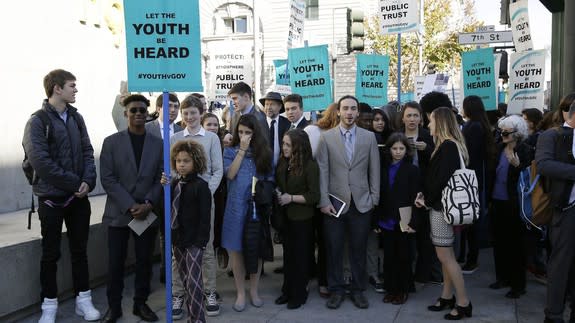Youth climate trial reaches federal appeals court, as judges signal it's going to trial

A landmark case involving a group of 21 young Americans who are suing the federal government for its failure to protect them from the adverse consequences of climate change is inching closer to a trial date.
The case, known as Juliana v. United States, was scheduled to go to trial in Oregon beginning on Feb. 5. That court date has been postponed due to a rare request from the federal government to have an Appeals Court step in and halt the proceedings.
On Monday, a panel of judges from the Ninth Circuit Court of Appeals heard arguments regarding the Trump administration's move to squash the case using a little-used legal tactic known as a writ of mandamus. If granted, the writ would have the Appeals Court review a 2016 U.S. District Court decision not to dismiss the case. If the Appeals Court grants the writ, it could halt the case in its tracks, preventing a trial by declaring that the District Court made one or more errors in its consideration of the case.
SEE ALSO: To obtain funding, scientists may be avoiding use of the term 'climate change' in research proposals
However, questions from the three-judge Appeals Court panel to the Justice Department indicated they are skeptical of the need to review the District Court's decision. The Justice Department argued that this case, which seeks a remedy involving government action to address global warming, is "unprecedented" for its claims and broad scope, among other factors.
The case already broke new legal ground when a District Court judge declared the plaintiffs have a constitutional right to a stable climate.
Among the issues to be determined at trial is whether the government's actions — including its use of federal lands for energy extraction over the past several decades (the years when scientists' understanding of global warming solidified) — violated the plaintiff's constitutional rights.

The case asks the judicial branch to help determine the remedy to ensure the plaintiff's rights are no longer being violated. This could mean that the courts tell the government what its climate policy should be, which traditionally is the purview of the legislative and executive branches of government, not the courts. (That breach is one of the arguments put forward by the Justice Department to halt the case.)
"This court is on a collision course with the Executive Branch," said Eric Grant, a deputy assistant attorney general.
However, Julia Olson, the lead attorney for the plaintiffs who works for Our Children's Trust, an advocacy group, rejected that argument. She was accompanied in the courtroom by her co-counsel, as well as 18 of the 21 plaintiffs.
“Plaintiffs seek a judicial safeguard against the continued degradation of their rights," she said — but this safeguard could come from the appropriate branch of government, meaning that the plaintiffs are not asking the courts to set climate policy. Rather, a possible remedy would be for the court to demand that the government enact policies to cut global warming pollutants, leaving the specific details up to Congress and federal agencies.
“What the complaint alleges is that the federal defendants collectively and through the fossil fuel energy system are affirmatively depriving these young people of their rights to life, liberty, and property,” Olson said.
In response to judges' questions about whether the plaintiffs have legal standing to sue on the basis of being deprived of a stable climate, Olson said yes, because they will experience a rapidly deteriorating climate system for the rest of their lives unless action is taken soon.
“Children are disproportionately experiencing the impacts of climate change,” Olson said. She noted that children will bear the brunt of the impacts of global warming, giving them standing in their case.
“Your honor, these children will live far longer than you, they will live till the end of the century, when the seas are projected by these federal defendants to be 10 feet higher,” she said.
18 of the 21 youth-plaintiffs were before the 9th Circuit in San Francisco challenging the U.S. Government for not protecting them from #climate change. pic.twitter.com/zE0ltHO6BF
— Lyanne Melendez (@LyanneMelendez) December 11, 2017
“The significance of the harm, the monumental threat that these injuries pose to these plaintiffs is very distinguishable from the rest of the country.”
Once the Ninth Circuit rules on the writ of mandamus, the case will either proceed to trial in District Court in Oregon, or head down another unprecedented path.
Many experts have consistently underestimated the likelihood that this suit would reach this far, considering how other judicial approaches to address climate change have failed.
If the 21 young people succeed in getting a judge to order the Trump administration to alter its pro-drilling, climate denial policies, they will have succeeded where no environmental activists or international allies have, simply by alleging a constitutional violation of their rights.
While this is an unlikely outcome, it gets more and more plausible with each passing legal proceeding.
WATCH: Different parts of the US are experiencing totally opposite weather extremes


